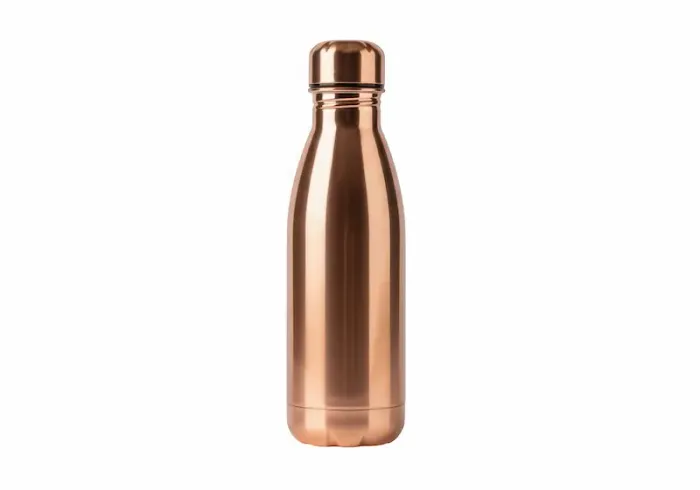Health Benefits of Drinking Water from Copper Bottles
Curious about copper bottle benefits? Get evidence-based guidance on ayurvedic water, safety limits, who should avoid it, and how to use copper bottles wisely.


Introduction: Why People are Talking About Copper Bottles
Copper bottles are popular again, thanks to ancient traditions and modern wellness trends. Many people ask about copper bottle benefits and whether “ayurvedic water” (water stored in a copper vessel) is truly good for you. Copper is an essential trace mineral, so it’s natural to wonder if using a copper bottle can support health—or if there are risks to consider. This guide explains what science says, who should be cautious, and how to use copper bottles safely if you choose to try them.
Consult a Top General Practitioner for Personalised Advice
What We know About Copper and Your Health
Copper is an essential mineral your body needs in small amounts for:
- Energy production and metabolism
- Formation of connective tissue and collagen
- Iron transport and red blood cell formation
- Brain development and immune function
- Antioxidant defence (as part of enzymes like superoxide dismutase)
How Much Copper Do You Need?
Amounts of copper you need include:
- Most adults need about 900 micrograms (0.9 mg) of copper per day from food, according to nutrition authorities.
- A wide variety of foods naturally contain copper, including nuts, seeds, whole grains, shellfish, legumes, and organ meats.
- There’s also a tolerable upper intake level (UL) for adults of 10 mg/day from all sources. Regularly exceeding that amount can be harmful.
Key point: Your body needs copper—but more is not necessarily better. Most people meet their needs through diet without needing extra copper from water or supplements.
What are the Copper Bottle Benefits You Might Expect?
People turn to copper bottles for a few reasons:
- Tradition and habit-building: In many cultures, especially within Ayurveda, storing water in copper vessels (often called ayurvedic water or tamra jal) is a longstanding practice. For some, the ritual encourages regular hydration, which is a genuine health benefit in itself.
- Potential antimicrobial effect: Copper is well known for its ability to inactivate certain microbes on surfaces in laboratory settings. Some small studies suggest that water stored in copper vessels may see a reduction in certain bacteria over time. This does not replace safe, treated drinking water or modern sanitation practices.
- Taste and palatability: Some people find that water from copper vessels tastes different and may drink more water as a result. This is subjective and varies from person to person.
What Science Can and Cannot Promise?
The science says:
- Copper’s antimicrobial properties are real in lab and controlled settings, but the real-world protection you’d get just by using a copper bottle is uncertain.
- There is no high-quality evidence that copper bottles produce unique health outcomes like weight loss, detoxification, better digestion, or skin improvement beyond the general benefits of staying well hydrated.
Bottom line: If you enjoy the practice, copper bottles can be part of a healthy hydration routine. Just don’t expect them to function as a water purifier or a cure for health issues.
What is Ayurvedic Water (tamra jal)?
In Ayurveda, ayurvedic water refers to water stored in a copper vessel for a period of time, traditionally overnight. The practice is believed to balance the body’s doshas. From a modern medical perspective:
- Cultural tradition: The practice has cultural significance and may support mindful hydration.
- Scientific evidence: There is limited clinical evidence to prove specific health outcomes from ayurvedic water. Claims should be viewed as traditional rather than scientifically established.
- Safety still matters: The same safety guidance about copper exposure applies here (see below).
Safety First: How Much Copper in Water is Considered Safe?
Safety tips while drinking water in a copper vessel:
- International guideline values: Health authorities set recommendations for copper in drinking water to reduce the risk of stomach upset and other adverse effects. These guideline values are in the low milligrams per litre (mg/L) range.
- What too much copper can do: Drinking water with elevated copper can cause short-term symptoms like nausea, stomach cramps, vomiting, or diarrhoea. Chronic high exposure can affect the liver or kidneys in severe cases.
- Taste and staining clues: Water with high copper levels can sometimes taste metallic and may leave blue-green stains on sinks or fixtures—signs to have your water tested.
Important: If you have copper plumbing, copper can leach into standing water (especially in newer pipes or with more acidic water). Letting tap water run for a short time in the morning before filling a glass or bottle can help flush water that’s been sitting in copper pipes.
Who Should Avoid Copper Bottles?
Avoid copper bottles in the following situations:
- People with Wilson disease or other copper metabolism disorders: These conditions cause copper to build up in the body. Using copper bottles is not recommended unless a specialist specifically approves.
- Infants (especially formula-fed): Babies are more sensitive to excess copper. Use safe, treated water sources and follow pediatric guidance for preparing infant formula.
- People advised by a clinician to limit copper: If you have liver disease or other health issues, check with your healthcare professional.
- Anyone with unknown water quality: If your local water is corrosive or already high in copper (from pipes or well water), adding more contact with copper isn’t advisable without testing.
Practical Safety Tips if You Choose a Copper Bottle
If you like the tradition and want to use a copper bottle safely, these tips can help:
- Start with safe water: Use properly treated and potable water. Copper bottles are not water purifiers.
- Avoid acidic or hot liquids: Acidic drinks (e.g., lemon water, citrus juices, vinegar-based drinks, soda) and hot liquids can increase copper leaching from the container.
- Keep storage times reasonable: Longer contact time can increase copper release. Many people use copper bottles to fill and drink the same day rather than storing water for extended periods.
- Clean gently and regularly: Wash the inside with mild dish soap and a soft bottle brush. Rinse thoroughly and air-dry with the cap off. Avoid abrasive cleaners that can scratch the surface.
- Don’t use if damaged: If the interior is pitted, corroded, or heavily worn, replace the bottle.
- Know your home’s copper levels: If you have copper plumbing, consider testing your water or asking your local water provider for a water quality report.
- Rotate materials if you’re concerned: You can alternate between copper and inert materials (like stainless steel or glass) to limit cumulative exposure.
How Do Copper Bottles Compare with Other Materials?
The comparison includes:
- Stainless steel: Durable and generally inert. Little concern for metal leaching under normal use. Easy to clean.
- Glass: Inert and flavour-neutral. Heavier and breakable, but a good option if you want zero interaction with water.
- Plastic: Lightweight. Choose BPA-free products and replace them if scratched or worn to minimise potential chemical leaching.
- Copper: Durable but reactive. May release copper into water depending on time, temperature, and acidity. Requires mindful use if you’re concerned about total copper exposure.
Are the Copper Bottle Benefits Worth it?
Let's look at the benefits of a copper bottle:
- If you enjoy the ritual, like the look and feel, and follow safety steps, a copper bottle can be part of a healthy hydration habit.
- If your goal is water safety, rely on properly treated water and certified filtration rather than the antimicrobial properties of copper alone.
- If you need to limit copper (due to health conditions or local water quality), consider stainless steel or glass instead.
Common myths about copper bottles—what the evidence says
Myths about copper bottles include:
- Myth: Copper bottles detoxify the body. Reality: Your liver and kidneys do the detox work. Hydration supports those organs, but copper bottles don’t “detox” on their own.
- Myth: Copper water kills all germs. Reality: Copper has antimicrobial properties, but real-world water safety depends on using clean, treated water and proper hygiene.
- Myth: More copper is always better. Reality: Copper is essential in small amounts, but excess can cause health problems.
Signs You May Be Getting Too Much Copper From Any Source
Signs of too much copper include:
- Short-term: Metallic taste, nausea, abdominal cramps, vomiting, or diarrhoea.
- Longer-term (with chronic high intake): Potential liver or kidney issues in severe cases.
- If you experience symptoms after using a copper bottle, stop using it, switch to a non-reactive bottle, and speak with a healthcare professional.
Quick Guide to Using a Copper Bottle Wisely
Quick guide includes:
- Use: Fill with safe, treated water; avoid acidic/hot drinks.
- Clean: Daily with mild soap; rinse and dry thoroughly.
- Replace: Swap the bottle if the interior shows pitting/corrosion.
- Monitor: If your water sits in copper plumbing, flush the tap briefly before filling.
- Personalise: If you’re unsure about your copper intake, alternate with stainless steel or glass.
Conclusion
Copper bottles can be part of a healthy hydration routine, especially if the practice helps you drink more water. However, “copper bottle benefits” beyond hydration are not strongly proven, and ayurvedic water should be viewed as a traditional practice rather than a medical treatment.
If you choose to use a copper bottle, do it safely: start with clean water, avoid acidic or hot drinks, limit storage time, clean the bottle regularly, and be mindful of your total copper exposure. When in doubt, talk with a healthcare professional.
Consult a Top General Practitioner for Personalised Advice
Consult a Top General Practitioner for Personalised Advice

Dr. Rupam Chowdhury
Orthopaedician
10 Years • MBBS, DNB (Ortho.)
Kolkata
MCR SUPER SPECIALITY POLY CLINIC & PATHOLOGY, Kolkata

Dr. Arif Ahmed
General Physician/ Internal Medicine Specialist
9 Years • MBBS, MD (Genl. Med.)
Kolkata
MCR SUPER SPECIALITY POLY CLINIC & PATHOLOGY, Kolkata

Dr. Debdatta Pati
Psychiatrist
18 Years • MBBS, DPM, MD (PSYCHIATRY)
Kolkata
MCR SUPER SPECIALITY POLY CLINIC & PATHOLOGY, Kolkata

Dr. Pinaki Mukhopadhyay
General Physician/ Internal Medicine Specialist
32 Years • MBBS
Kolkata
MCR SUPER SPECIALITY POLY CLINIC & PATHOLOGY, Kolkata
(25+ Patients)

Dr. Mary Susan K S
General Physician/ Internal Medicine Specialist
13 Years • MBBS, MD INTERNAL MEDICINE
Bengaluru
Apollo Clinic, Sarjapur Road, Bengaluru
(25+ Patients)
Consult a Top General Practitioner for Personalised Advice

Dr. Rupam Chowdhury
Orthopaedician
10 Years • MBBS, DNB (Ortho.)
Kolkata
MCR SUPER SPECIALITY POLY CLINIC & PATHOLOGY, Kolkata

Dr. Arif Ahmed
General Physician/ Internal Medicine Specialist
9 Years • MBBS, MD (Genl. Med.)
Kolkata
MCR SUPER SPECIALITY POLY CLINIC & PATHOLOGY, Kolkata

Dr. Debdatta Pati
Psychiatrist
18 Years • MBBS, DPM, MD (PSYCHIATRY)
Kolkata
MCR SUPER SPECIALITY POLY CLINIC & PATHOLOGY, Kolkata

Dr. Pinaki Mukhopadhyay
General Physician/ Internal Medicine Specialist
32 Years • MBBS
Kolkata
MCR SUPER SPECIALITY POLY CLINIC & PATHOLOGY, Kolkata
(25+ Patients)

Dr. Mary Susan K S
General Physician/ Internal Medicine Specialist
13 Years • MBBS, MD INTERNAL MEDICINE
Bengaluru
Apollo Clinic, Sarjapur Road, Bengaluru
(25+ Patients)
More articles from General Medical Consultation
Frequently Asked Questions
1) Are copper bottles scientifically proven?
Some lab studies suggest copper surfaces and copper vessels can reduce certain bacteria, but evidence that copper bottles improve health outcomes in everyday use is limited. The main proven benefit of any bottle is that it helps you drink enough safe water.
2) Is ayurvedic water backed by modern research?
Ayurvedic water (water stored in copper vessels) is a respected traditional practice. Modern clinical evidence for specific health benefits is limited. If you enjoy the practice, use it safely and view it as complementary—not a replacement for evidence-based care.
3) Can I put lemon water or hot tea in a copper bottle?
It’s best not to. Acidic and hot liquids can increase copper leaching into your drink. Use copper bottles for plain, cool water only.
4) How can I tell if I’m getting too much copper?
Watch for a metallic taste, nausea, stomach cramps, vomiting, or diarrhoea. If symptoms occur, stop using the copper bottle and consult a healthcare professional. If your home has copper plumbing or a private well, consider testing your water.
5) Who should avoid copper bottles?
People with Wilson disease or other copper metabolism disorders, infants, and anyone advised by a clinician to limit copper should avoid copper bottles. If you’re pregnant or have liver disease, ask your clinician before use.




